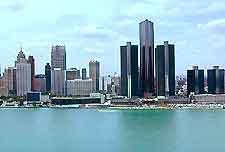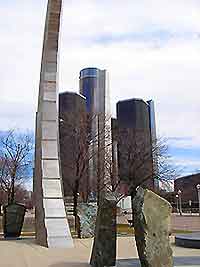Detroit History Facts and Timeline
(Detroit, Michigan - MI, USA)

Known worldwide as simply the 'Motor City', Detroit straddles both banks of the Detroit River and is the 18th-largest conurbation in the US.
Its port is strategically located, with the Detroit River linking the St. Lawrence Seaway and the Great Lakes region. The city's downtown district is now a famous entertainment hub with casinos, luxury resorts and a vibrant riverfront area.
Early Days
Early city history began with a humble settlement on the north bank of the Detroit River in 1701. The establishment of the settlement followed French explorer Antoine de la Mothe's arrival in 1679. The first colony was named Fort Pontchartrain du Detroit and was home to a small number of French-Canadian settlers.
Within 65 years, the fort-based community had grown in population to over 800 residents, due to the French government's granting of free parcels of land to incomers, with its economy dependent at first on the fur trade. Conflict followed in the form of the French and Indian War (1754 to 1763), with British troops entering the French colony in 1760 and shortening its name to Detroit. Pontiac's Rebellion, led by Native American Chief Pontiac, saw the city under siege until 1763, when the natives withdrew.
Fire and Conflict
The city passed from British to US control in 1796, as a result of the Jay Treaty, and later suffered total destruction by fire in 1805, with many lives lost and many businesses destroyed. After rebuilding, Detroit became the capital of Michigan State, although the War of 1812 saw British troops taking over the city for a year until its recapture by American brigades. In 1847, the capital was relocated to
Lansing.
Civil War and the 'Underground Railroad'
Due to its strategic location along the border with
Canada, the city was a major player in the 'underground railroad' route for escaped slaves from the south, helping scores by the mid-19th century. This involvement motivated many citizens to volunteer for the Union, resulting in the formation of the famous Iron Brigade and Abraham Lincoln's comment, 'Thank God for Michigan'. At the crucial Battle of Gettysburg in 1863, some 82 percent of Union forces from Michigan were allegedly injured or killed.

The Gilded Age and Prohibition History
Across the country in the late 19th and early 20th centuries, great civil buildings and private mansions were constructed during a period that is now known as the 'Gilded Age'. Detroit was no exception, capitalizing on its booming commercial and financial importance on the magnificent Washington Boulevard, with many other spectacular architectural wonders elsewhere. During this period in Detroit history, the city was known as the '
Paris of the West', with the motor manufacturing sector, including Ford, Chrysler, Dodge and Packard, strongly established.
The smuggling of alcohol across the Canadian border became established equally quickly during Prohibition (1920 to 1933). This period saw a rise in mafia organizations such as the Purple Gang, dedicated to serving the dry throats of the population, as well as their own financial status. Labor unions arrived in the 1930s, with Jimmy Hoffa's Teamsters linked with the mob, thus increasing the mob's chaos-causing influence.
Late 20th Century to the Present Day
In the late 20th century, downtown Detroit suffered due to local government policies, which resulted in many businesses either failing or leaving. Competition from Japan saw the motor industry in decline, leading to widespread job losses. Renaissance has since become a buzzword, with the districts of Downtown, Midtown and New Center focuses for rebranding.
Downtown football and baseball stadiums have been built, and new resort hotels with casinos and entertainment hubs have sprung up. The skyscrapers of the Renaissance Center on the waterfront now dominate the Detroit cityscape, being surrounded by parks, fountains and a new passenger terminal for river travel.
 Known worldwide as simply the 'Motor City', Detroit straddles both banks of the Detroit River and is the 18th-largest conurbation in the US.
Known worldwide as simply the 'Motor City', Detroit straddles both banks of the Detroit River and is the 18th-largest conurbation in the US.